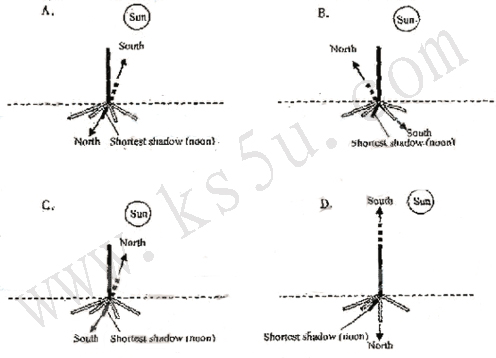题目内容
Find Which Direction Is South
Do you have a good sense of direction? If not, please take with you a compass. But if you forget to take a compass, you can still find your way.
It’s never a good idea to imagine that the family member who was entrusted(委托)with the job of map-reading actually knows where the family is. You can tell by the slightly confused load on their faces that nothing on the ground seems to match the map. Never mind. The shu is shining and it’s still morning. If you don’t know the exact time, you can still find out where south is, but you’ll need to be patient.
①Find a straight sick and put it in the ground in a place where you can mark its shadow.
②Try to position the stick as vertically(垂直)as you can. You can check this by making a simple plumb line (铅锤线)with a piece of string and weight. You haven’t got any string? OK, use a thread from your clothes with a button tied at the end to act as a weight.
③Mark the end of the shadow cast by the stick.
④Wait approximately half an hour and mark the end of the shadow again.
⑤Keep doing this until you have made several marks.
⑥The mark nearest the stick will represent the shortest shadow, which is cast at midday, when the sun is highest in the sky and pointing to the exact south.
⑦Pick a point in the distance along the line between the shortest shadow and the stick.
⑧That point is south of where you are.
⑨Now you can turn the map, like you did before, and find which way you should be travelling.
1.To find the direction, we ought to be patient probably because
A. it is not easy to find a proper stick B. it is not easy to position the stick
C. it takes hours to make the marks D. it takes about half an hour to make the marks
2.The passage would probably be most helpful to .
A. those who draw maps B. those who get lost
C. those who make compasses D. those who do experiments
3.Which of the following pictures best shows the way of finding the direction of south?

4.The author presents this passage by .
A. telling an interesting story B. describing an activity in a lively way
C. testing an idea by reasoning D. introducing a practical method
1.C 推理判断题。根据文章中的辨别方向的步骤可以推断出这种方法需要花费时间,故本题选C。
2.B 推理判断题。根据文章第二自然段大意可知本题选B。
3.A 推理判断题。由文章介绍的辨别方向的步骤可知本题A项正确。
4.D 推理判断题。由文中所介绍的辨别方向的办法可知这种方法简单易行,也很实用,选D。
【解析】文章大意
你的方向感怎么样?来到一个陌生的地方,如果没有指南针,你将如何判断方向你?本文介绍给我们一种辨别方向的方法。

 阳光课堂课时优化作业系列答案
阳光课堂课时优化作业系列答案Plants have family values, too; it seems, with new research suggesting they can recognize close relatives in order to work together.
An ability to tell family from strangers is well known in animals, allowing them to cooperate and share resources, but plants may possess similar social skills, scientists believe.
Susan Dudley and Amanda File of McMaster University in Ontario, Canada, report they have demonstrated for the first time that plants can recognize their kin.
This suggests that plants, though lacking recognition and memory, are capable of complex social interactions.
“Plants have this kind of hidden but complicated social life,” Dudley said.
The study found plants from the same species of beach-dwelling wildflower grew aggressively alongside unrelated neighbors but were less competitive when they shared soil with their families.
Sea rocket, a North American species, showed stronger and healthier root growth when planted in pots with strangers than when raised with relatives from the same maternal(母系的) family, the study found.
This is an example of kin selection, a behavior common in animals in which closely related individuals take a group approach to succeeding in their environment, the researchers said.
Kin selection also applies to competition, because if family members compete less with each other, the group will do better overall. “Everywhere you look, plants are growing right up next to other plants,” Dudley said,“ Usually it’s a case of each plant for itself. But sometimes those plants are related, and there are benefits to not wasting resources on being competitive, and there is not really a cost to not being competitive as long as your neighbor is also not being competitive.”
Learning and memory appear to be important for kin recognition in animals, but this isn’t an option for plants, she noted.
Some researchers speculate(猜测) that plants communicate through their roots, identifying themselves using tiny chemical signatures specific to each plant’s family.
【小题1】What’s the main idea of the message?
| A.Studies find plants can recognize, communicate with relatives. |
| B.Kin selection is important for plants. |
| C.Animals can recognize and memorize their relatives. |
| D.Competition asks plants to recognize their relatives. |
| A.Animals can recognize and memorize their relatives. |
| B.Animals’ social skill is to cooperate and share resources. |
| C.Animals’ social skill can recognize close relatives in order to work together. |
| D.Animals’ social skill is no use at all. |
| A.grow well | B.compete with other kinds of plants |
| C.strengthen the relationship among siblings | D.find which one is the best |
| A.sea rocket is a South American species |
| B.sea rocket grows aggressively alongside unrelated neighbors |
| C.sea rocket grows aggressively alongside its siblings |
| D.sea rocket is a kind of bush without flowers |
| A.Plants communicate by using tiny chemical signatures specific to each plant’s family. |
| B.Plants communicate with each other through their roots. |
| C.Plants communicate with each other by their leaves. |
| D.Plants communicate with each other with their flowers. |
